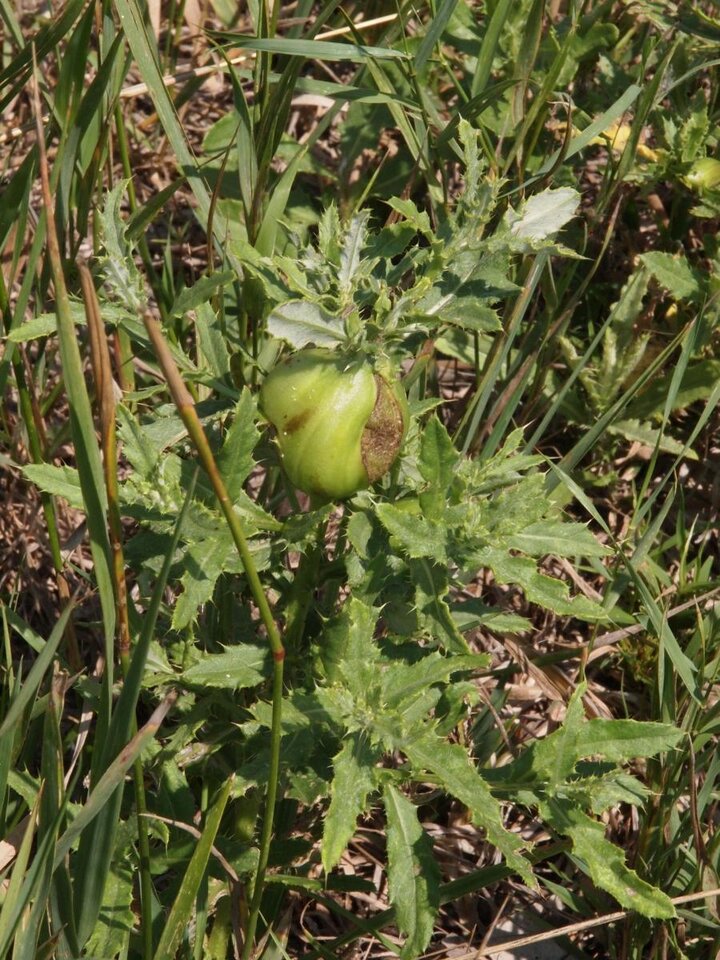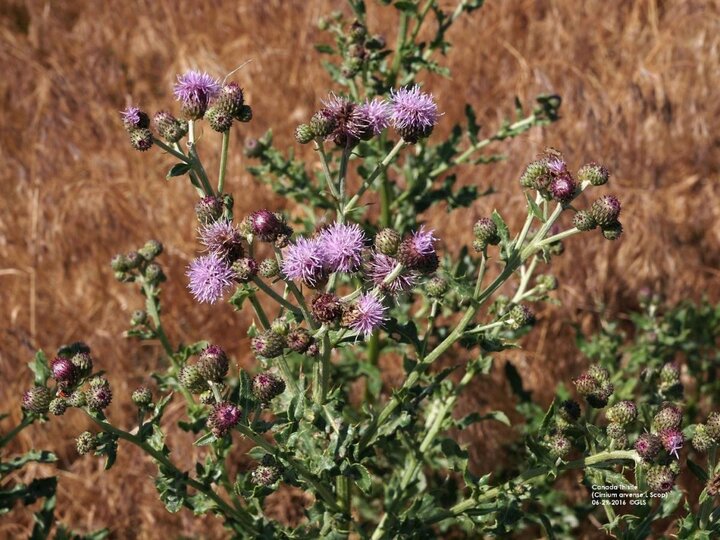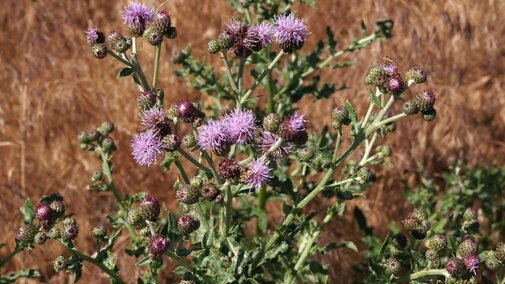Early Detection and Rapid Response (EDRR) is a concept to identify potentially invasive species prior to or just as the establishment of the invasive is taking place.
An Integrated Pest Management plan (IPM) can be developed to manage, contain and eradicate the invasive species before it can spread further. This will avoid costly, long-term control efforts.
Canada Thistle (not Canadian Thistle)
a.k.a. – Creeping thistle, California thistle
Scientific name: Cirsium arvense L.
Family: Asteraceae (Sunflower family)
Description
Origin: Eurasia and North Africa. Introduced into the United States around 1750.
Canada thistle is a non-native perennial forb that reproduces/spreads from seed and rhizomes. Plants are either male or female (dioecious) so cross pollination is necessary for seed production. Flowering occurs late spring into summer in response to 14-hour days and are pink to purple in color. Plants generally grow in circular patches that are one clone and sex.
Each thistle plant can produce 1,000 up to 1,500 seeds per shoot. Seed can remain viable over 20 years. Germination of seed and emergence of plants from rhizomes generally occur at the same time. Seed can germinate on the soil surface or to a depth of 3 inches in the soil. The greatest number of plants from rhizomes usually occur in the spring and then another flush in the fall. Roots can spread laterally 12 to 18 feet and be as deep as 6 to 15 feet. New plants and roots can form from anywhere along the root system. Local spread of the plant is usually by the root system and long-distance dispersal by the seed. Seed can be spread by wind, water, livestock, wildlife, vehicles, contaminated crops, and humans. Canada thistle plants are usually 2 to 4 feet tall or taller with alternate dark green leaves and an extensive root system. Thistle plants produces many seed heads on erect branching stems.



Habitat
Canada thistle is found in any type of habitat but normally establishes quickly in disturbed areas. It can also be found in roadsides, pastures, rangeland, cropland and riparian areas. Canada thistle is found across most of North America. It can invade healthy, undisturbed sites as well, out-competing desirable forbs and grasses in pastures and rangeland, reducing biodiversity and forage production. When present in cropland, it can reduce yields. Canada thistle is not palatable to livestock.
Management
Canada thistle is a designated noxious weed under the Nebraska Department of Agriculture’s Noxious Weed Program. Prevention is the best and cheapest management option. Having well-established perennial grasses and forbs on a maintained pasture or rangeland with proper grazing and rotational grazing techniques can go a long way to prevent its establishment. Scouting, monitoring and proper identification are key factors for management. Infestations of this weed can occur very rapidly. Several different management options will need to be utilized to manage this weed. Stressing the plant to force it to use up its root reserves is a key for successful management.
Some biological management measures include the larvae of the Painted lady, Admiral and Viceroy butterflies which feed on the foliage of Canada thistle and can defoliate the plant. The thistle stem weevil larvae (Ceutorhynchus litura) feeds on young thistle plant stems as they elongate. Thistle stem gall fly larvae (Urophora cardui) attack the primary lateral stems. The developing larvae in the stem causes the plant to form a gall on the stem which weakens the plant (Photo 2). There are also several pathogens that may help suppress thistle growth, a thistle rust fungus, white mold and a bioherbicide (Pseudomonas syringae). These biological control measures will not completely manage / control Canada thistle alone, but are an IMP tool and help suppress growth.
Mowing can be done prior to flowering to help reduce seed production and force new growth from the roots. An herbicide treatment will be necessary with either the biological or mowing management options for effective control.
There are numerous chemical treatment options available to manage Canada thistle. Products containing aminopyralid, clopyralid, chlorsulfuron, dicamba, metsulfuron, picloram (Restricted Use), triclopyr, glyphosate (non-selective) and 2,4-D have been shown to work. Spring and fall applications may be necessary for effective control. Fall treatments are better after a light freeze. Tank mixes of several of these compounds may provide better control. The addition of a non-ionic surfactant to the herbicide mix will aid in control. Re-treatment may be necessary until the seed in the soil and the plant’s root reserves are exhausted. Be sure to select a product labeled for the site. Read, understand and follow all label instructions when using any pesticide.
Nebraska Extension Publications has a number of publications on thistle management and other invasive species. These publications and much more are found at http://extensionpubs.unl.edu/. Search “thistle” or “invasive”.
References
Beck, K.G., “Canada Thistle”, Colorado State University, Fact Sheet 3.108
Grover, A., et al, “Managing Canada Thistle”, Penn State, Conservation Reserve Enhancement Program (CREP) Technical Assistance Series Fact Sheet 1
Stubbendieck, J., et al, “Weeds of the Great Plains”, Nebraska Department of Agriculture, 2019
Wilson, R., “Noxious Weeds of Nebraska Canada Thistle”, University of Nebraska, EC171

